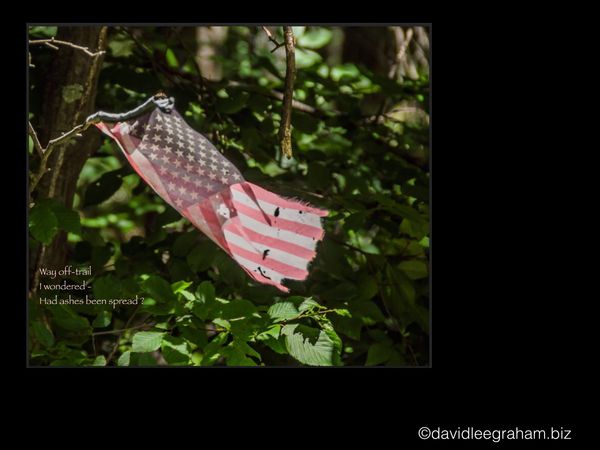Another Haiga - with a Haiku "How-To"
Oct 21, 2015 01:57:49 #
As a long-time collector and writer of haiku and composer of Haiga (a combination of an image with a related haiku poem) I sometimes forget that many are not as familiar with the haiku poem form as I have become.
Vast libraries of haiku collections and many treatises on writing haiku are available, but (IMO) one of the most lucid and well-written pieces on what haiku are and how to write them is found at:
http://www.ahapoetry.com/h_t_techniques.html
And here's a haiga that presented itself to me almost fully formed during a hike through the Wisconsin North Woods a couple years ago.
Dave
Vast libraries of haiku collections and many treatises on writing haiku are available, but (IMO) one of the most lucid and well-written pieces on what haiku are and how to write them is found at:
http://www.ahapoetry.com/h_t_techniques.html
And here's a haiga that presented itself to me almost fully formed during a hike through the Wisconsin North Woods a couple years ago.
Dave
Oct 21, 2015 10:02:03 #
I remember this picture, Dave. I like it very, very much, and the haiku is, I think, perfect (and perhaps spot-on). :)
Oct 21, 2015 10:51:00 #
Chuck_893 wrote:
I remember this picture, Dave. I like it very, very much, and the haiku is, I think, perfect (and perhaps spot-on). :)
Thanks, Chuck; I'm glad you recall it. I posted it, I think, in the Critique Section before it occurred to me to actually post it as a haiga.
I do hope that some who may be inclined in the haiga direction may follow that link on haiku for some excellent coaching in that direction.
Dave
Oct 21, 2015 21:42:21 #
Thank you for the link Dave, it has been a looong time since I was introduced to Haiku and mostly forgot about it, (not having a "photographic memory"). Maybe I should look at this because it isn't rhymed and I had thought there was always the same # of syllables per line but see in the example you have been posting that isn't true. One could write a caption and not realize it was Haiku, and do it badly! :)
Oct 22, 2015 12:23:53 #
jenny wrote:
Thank you for the link Dave, it has been a looong time since I was introduced to Haiku and mostly forgot about it, (not having a "photographic memory"). Maybe I should look at this because it isn't rhymed and I had thought there was always the same # of syllables per line but see in the example you have been posting that isn't true. One could write a caption and not realize it was Haiku, and do it badly! :)
Xxxxx
Hi, Jenny,
Every one of your points is spot-on!
From my perspective, the only folks who get to lay down the laws about haiku are the Japanese.and even they have fudged a bit with the formal characterization of haiku ( once " hokku" when they were the introductory stanzas to a much longer poem form known as renga.)...
Anyway, just after WWII haiku gained popularity and avid followers/practitioners throughout the world ...not only in the USA and Canada, but in Romania, Italy, Spain, Poland, Russia, the Scandinavian countries, Mexico... in lotsa places...and within the contexts of lotsa languages...and the Japanese politely ( as is the way of that polite society) laugh up their sleeves at the various forms their literary invention has taken as it has been adapted to widely differing language traditions.
The bottom line is that in Japanese the haiku form is strictly based on 17 "on" or "onji" (which are functionally closer to phonemes than they are to syllables. A classic example of the difference is the word "fish" which is one syllable in English, but which contains three "onji" to a Japanese listener ( "gh", the /f/ sound in "enough", "o", the /i/ sound in "women", and "ti", the /sh/ sound in "nation"). That "old saw" originally coined to emphasize the irregularities inherent in English pronunciation and orthography finds apt application in the point made here.
And so, to the Japanese an American haiku with three lines containing 5-7-5 "syllables" sounds far more "information-dense" and "wordy" than does a 17 "onji" haiku in Japanese. When a Japanese haijin (haiku poet) who is bilingual in English composes an English haiku it is rarely is longer than eight-to 11 English syllables.
There are, today, basically (some would say "...at the very least) three styles of haiku construction in English, the "Schoolbook" haiku, based on three non-rhyming lines of 5-7-5 syllables (17 total syllables), the less strictly structured "haiku" of (approximately) 8 to 12 English syllables, as well as rhyming English haiku of the 5-7-5 syllable variety favored by a few.
So...."Y' pays y'r money and takes y'r cherse !" (As expressed in traditional Brooklynese...).... Yeah...that's an attempt at a bit of weak linguo-humor....
So, Jenny, I commend your observations and astute conclusions regarding the "morphing" of haiku as that originally Japanese literary form endures it's often inadequately "guided tour" through non-nipponese language traditions and rules.
Dave
Oct 22, 2015 12:38:53 #
Thank you Dave! That seems to give me permission to go back to concentrating on finding the hidden secrets embedded in the darned Oly Om E manual, which no doubt stems from problems translating information to English! :) :) :) Looks like Haiku will have to await another day, another time, as I had no idea of its "morphing".
If you want to reply, then register here. Registration is free and your account is created instantly, so you can post right away.


